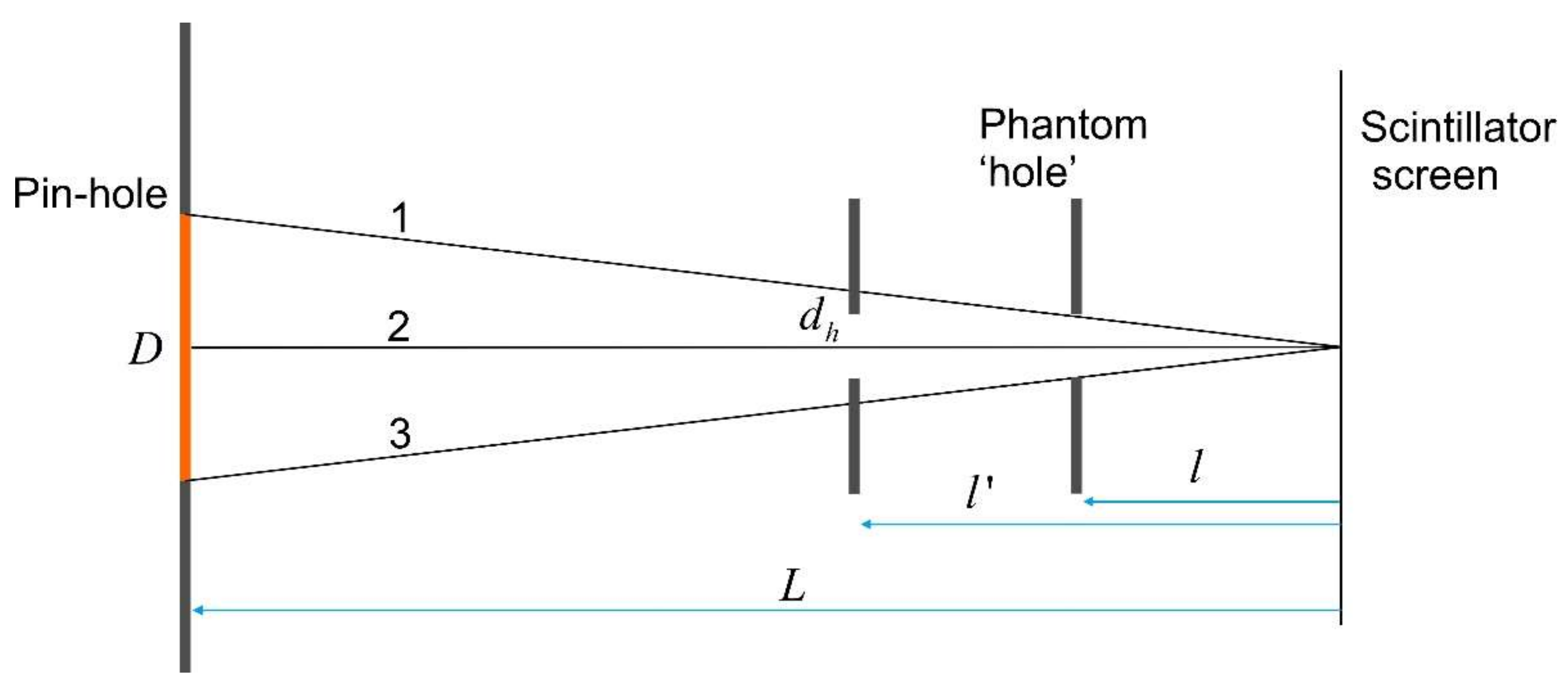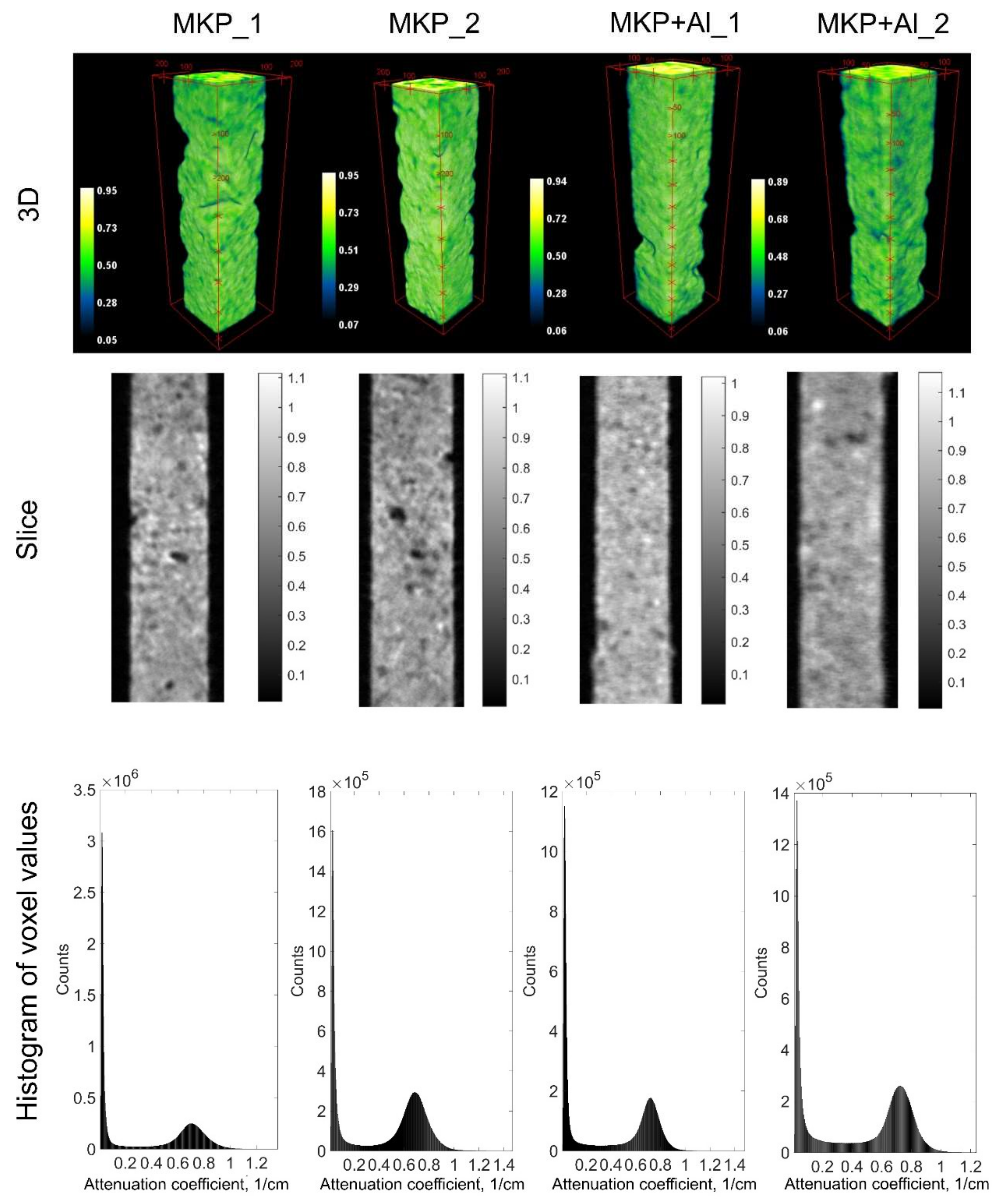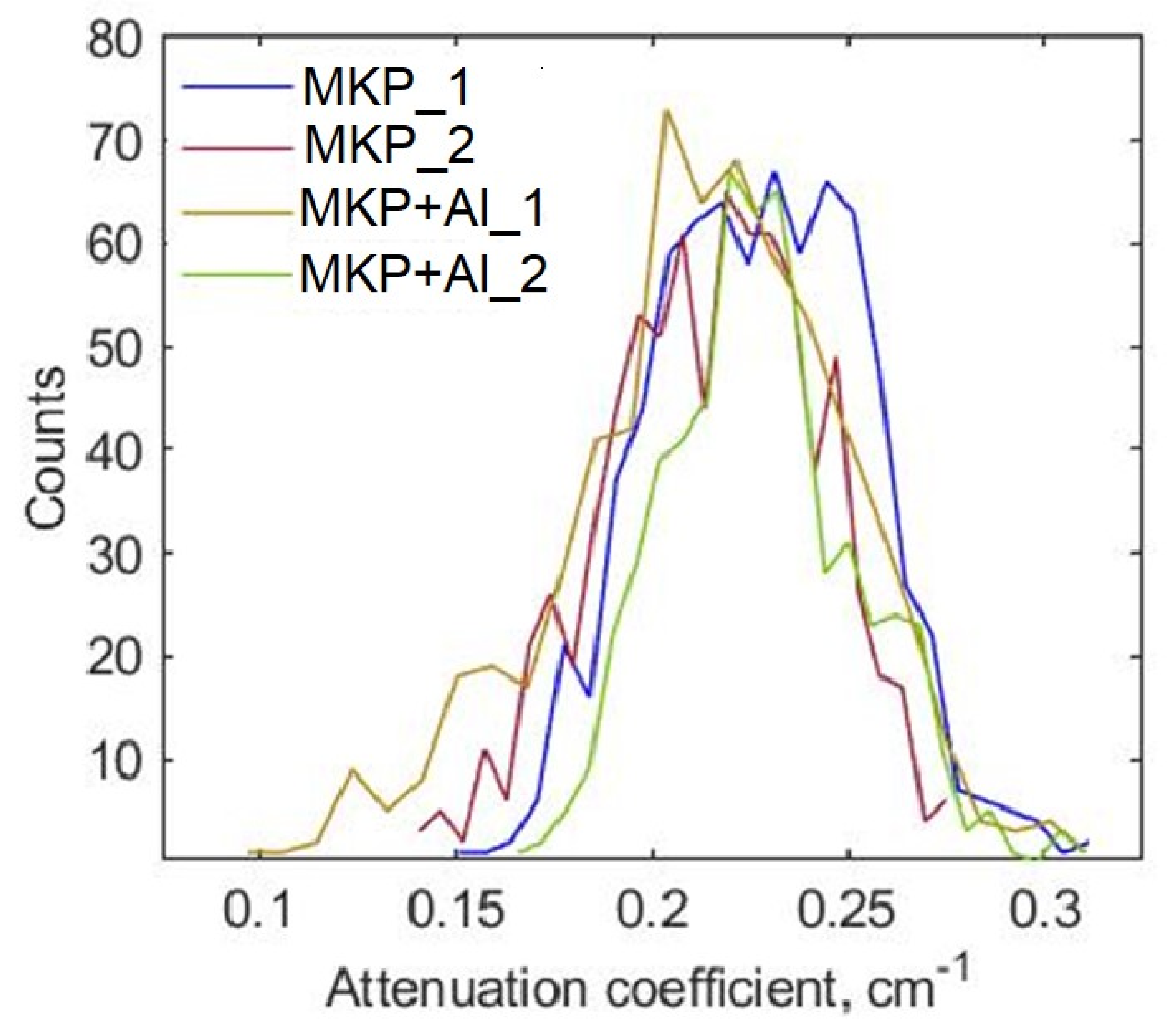Pore Segmentation Techniques for Low-Resolution Data: Application to the Neutron Tomography Data of Cement Materials
Abstract
:1. Introduction
2. Pore Segmentation Techniques
2.1. Global Threshold of the Enhanced Contrast Data
2.2. Watershed-Based Techniques
2.2.1. Conventional Approach (WS)
2.2.2. Local Threshold by Watershed (LTWS)
3. The Segmentation Test
4. Application to the Neutron Tomography of MKP Cements
4.1. Experimental
4.2. Pore Segmentation Results
5. Conclusions
Author Contributions
Funding
Institutional Review Board Statement
Informed Consent Statement
Data Availability Statement
Acknowledgments
Conflicts of Interest
References
- Lehmann, E.H. Neutron imaging facilities in a global context. J. Imaging 2017, 3, 52. [Google Scholar] [CrossRef]
- Podurets, K.M.; Kichanov, S.E.; Glazkov, V.P.; Kovalenko, M.M.; Murashev, D.P.; Kozlenko, D.P.; Lukin, E.V.; Yatsishina, E.B. Modern methods of neutron radiography and tomography in studies of the internal structure of objects. Crystallogr. Rep. 2021, 66, 254–266. [Google Scholar] [CrossRef]
- Strobl, M.; Manke, I.; Kardjilov, N.; Hilger, A.; Dawson, M.; Banhart, J. Topical review: Advances in neutron radiography and tomography. J. Phys. D Appl. Phys. 2009, 42, 243001. [Google Scholar] [CrossRef]
- Zhang, P.; Wittmann, F.H.; Lura, P.; Müller, H.S.; Han, S.; Zhao, T. Application of neutron imaging to investigate fundamental aspects of durability of cement-based materials: A review. Cem. Concr. Res. 2018, 108, 152–166. [Google Scholar] [CrossRef]
- Zel, I.Y.; Kenessarin, M.; Kichanov, S.E.; Balasoiu, M.; Kozlenko, D.P.; Nazarov, K.; Nicu, M.; Ionascu, L.; Dragolici, A.C.; Dragolici, F. Spatial distribution of graphite in cement materials used for radioactive waste conditioning: An approach to analysis of neutron tomography data. Cem. Concr. Comp. 2021, 119, 103993. [Google Scholar] [CrossRef]
- Vontobel, P.; Lehmann, E.H.; Hassanein, R.; Frei, G. Neutron tomography: Method and applications. Phys. B Condens. Matter 2006, 385–386, 475–480. [Google Scholar] [CrossRef]
- Boillat, P.; Carminati, C.; Schmid, F.; Grünzweig, C.; Hovind, J.; Kaestner, A.; Mannes, D.; Morgano, M.; Siegwart, M.; Trtik, P.; et al. Chasing quantitative biases in neutron imaging with scintillator-camera detectors: A practical method with black body grids. Opt. Express 2018, 26, 15769–15784. [Google Scholar] [CrossRef]
- Abrosimov, K.N.; Gerke, K.M.; Semenkov, I.N.; Korost, D.V. Otsu’s algorithm in the segmentation of pore space in soils based on tomographic data. Eurasian Soil Sci. 2021, 54, 560–571. [Google Scholar] [CrossRef]
- Porter, M.L.; Wildenschild, D. Image analysis algorithms for estimating porous media multiphase flow variables from computed microtomography data: A validation study. Comput. Geosci. 2010, 14, 15–30. [Google Scholar] [CrossRef]
- Ketcham, R.A. Computational methods for quantitative analysis of three-dimensional features in geological specimens. Geosphere 2005, 1, 32–41. [Google Scholar] [CrossRef]
- Shah, S.M.; Gray, F.; Crawshaw, J.P.; Boek, E.S. Micro-computed tomography pore-scale study of flow in porous media: Effect of voxel resolution. Adv. Water Resour. 2016, 95, 276–287. [Google Scholar] [CrossRef]
- Peng, S.; Marone, F.; Dultz, S. Resolution effect in X-ray microcomputed tomography imaging and small pore’s contribution to permeability for a Berea sandstone. J. Hydrol. 2014, 510, 403–411. [Google Scholar] [CrossRef]
- Reinhardt, M.; Jacob, A.; Sadeghnejad, S.; Cappuccio, F.; Arnold, P.; Frank, S.; Enzmann, F.; Kersten, M. Benchmarking conventional and machine learning segmentation techniques for digital rock physics analysis of fractured rocks. Environ. Earth Sci. 2022, 81, 71. [Google Scholar] [CrossRef]
- Schluter, S.; Sheppard, A.; Brown, K.; Wildenschild, D. Image processing of multiphase images obtained via X-ray microtomography: A review. Water Resour. Res. 2014, 50, 3615–3639. [Google Scholar] [CrossRef]
- Iassonov, P.; Gebrenegus, T.; Tuller, M. Segmentation of X-ray computed tomography images of porous materials: A crucial step for characterization and quantitative analysis of pore structures. Water Resour. Res. 2009, 45, W09415. [Google Scholar] [CrossRef]
- Wildenschild, D.; Sheppard, A.P. X-ray imaging and analysis techniques for quantifying pore-scale structure and processes in subsurface porous medium systems. Adv. Water Resour. 2013, 51, 217–246. [Google Scholar] [CrossRef]
- Leu, L.; Berg, S.; Enzmann, F.; Armstrong, R.T.; Kersten, M. Fast X-ray micro-tomography of multiphase flow in Berea sandstone: A sensitivity study on image processing. Transp. Porous Med. 2014, 105, 451–469. [Google Scholar] [CrossRef]
- Soille, P. Morphological Image Analysis: Principles and Applications, 2nd ed.; Springer: Berlin/Heidelberg, Germany, 2002; pp. 206–207. [Google Scholar]
- Arias-Castro, E.; Donoho, D.L. Does median filtering truly preserve edges better than linear filtering? Ann. Stat. 2009, 37, 1172–1206. [Google Scholar] [CrossRef]
- Beucher, S. The watershed transformation applied to image segmentation. Scanning Microsc. 1992, 1992, 28. [Google Scholar]
- Schneider, C.A.; Rasband, W.S.; Eliceiri, K.W. NIH Image to ImageJ: 25 years of image analysis. Nat. Methods 2012, 9, 671–675. [Google Scholar] [CrossRef]
- Levandowsky, M.; Winter, D. Distance between sets. Nature 1971, 234, 34–35. [Google Scholar] [CrossRef]
- Ionascu, L.; Nicu, M.; Turcanu, C.; Dragolici, F.; Rotarescu, G.H. Study of the conditioning matrices for aluminium radioactive wastes. Rom. J. Phys. 2014, 59, 360–368. [Google Scholar]
- Kozlenko, D.P.; Kichanov, S.E.; Lukin, E.V.; Rutkauskas, A.V.; Belushkin, A.V.; Bokuchava, G.D.; Savenko, B.N. Neutron radiography and tomography facility at IBR-2 reactor. Phys. Part. Nuclei Lett. 2016, 13, 346–351. [Google Scholar] [CrossRef]
- Brun, F.; Massimi, L.; Fratini, M.; Dreossi, D.; Billé, F.; Accardo, A.; Pugliese, R.; Cedola, A. SYRMEP Tomo Project: A graphical user interface for customizing CT reconstruction workflows. Adv. St. Chem. Imaging 2017, 3, 4. [Google Scholar] [CrossRef] [PubMed]
- Münch, B.; Trtik, P.; Marone, F.; Stampanoni, M. Stripe and ring artifact removal with combined wavelet—Fourier filtering. Opt. Express 2009, 17, 8567–8591. [Google Scholar] [CrossRef] [PubMed]
- Andersen, A.H.; Kak, A.C. Simultaneous Algebraic Reconstruction Technique (SART): A superior implementation of the ART algorithm. Ultrason. Imaging 1984, 6, 81–94. [Google Scholar] [CrossRef] [PubMed]
- Sears, V.F. Neutron scattering lengths and cross sections. Neutron News 1992, 3, 26–37. [Google Scholar] [CrossRef]





| Method | s4_n_s2 | Method | s6_n_s2_n_s2 | Method | bck+s4_n_s2 | Method | bck+s6_n_s2_n_s2 |
|---|---|---|---|---|---|---|---|
| WS, t = 50 | 0.75 | WS, t = 52 | 0.52 | WS, t = 50 | 0.58 | WS, t = 60 | 0.52 |
| WS, t = 80 | 0.50 | WS, t = 69 | 0.47 | WS, t = 70 | 0.63 | WS, t = 80 | 0.46 |
| LTWS, t = 50 | 0.78 | LTWS, t = 52 | 0.57 | LTWS, t = 50 | 0.58 | LTWS, t = 60 | 0.52 |
| LTWS, t = 80 | 0.55 | LTWS, t = 69 | 0.65 | LTWS, t = 70 | 0.66 | LTWS, t = 80 | 0.56 |
| 0.79 | 0.61 | 0.67 | 0.60 |
| Method | MKP_1 | MKP_2 | MKP+Al_1 | MKP+Al_2 |
|---|---|---|---|---|
| Global threshold | 0.20 | 0.28 | 0.12 | 0.25 |
| 0.24 | 0.30 | 0.14 | 0.28 | |
| WS | 1.33 | 1.71 | 1.11 | 1.23 |
| LTWS | 0.41 | 0.44 | 0.40 | 0.37 |
Publisher’s Note: MDPI stays neutral with regard to jurisdictional claims in published maps and institutional affiliations. |
© 2022 by the authors. Licensee MDPI, Basel, Switzerland. This article is an open access article distributed under the terms and conditions of the Creative Commons Attribution (CC BY) license (https://creativecommons.org/licenses/by/4.0/).
Share and Cite
Zel, I.; Kenessarin, M.; Kichanov, S.; Nazarov, K.; Bǎlǎșoiu, M.; Kozlenko, D. Pore Segmentation Techniques for Low-Resolution Data: Application to the Neutron Tomography Data of Cement Materials. J. Imaging 2022, 8, 242. https://doi.org/10.3390/jimaging8090242
Zel I, Kenessarin M, Kichanov S, Nazarov K, Bǎlǎșoiu M, Kozlenko D. Pore Segmentation Techniques for Low-Resolution Data: Application to the Neutron Tomography Data of Cement Materials. Journal of Imaging. 2022; 8(9):242. https://doi.org/10.3390/jimaging8090242
Chicago/Turabian StyleZel, Ivan, Murat Kenessarin, Sergey Kichanov, Kuanysh Nazarov, Maria Bǎlǎșoiu, and Denis Kozlenko. 2022. "Pore Segmentation Techniques for Low-Resolution Data: Application to the Neutron Tomography Data of Cement Materials" Journal of Imaging 8, no. 9: 242. https://doi.org/10.3390/jimaging8090242
APA StyleZel, I., Kenessarin, M., Kichanov, S., Nazarov, K., Bǎlǎșoiu, M., & Kozlenko, D. (2022). Pore Segmentation Techniques for Low-Resolution Data: Application to the Neutron Tomography Data of Cement Materials. Journal of Imaging, 8(9), 242. https://doi.org/10.3390/jimaging8090242







